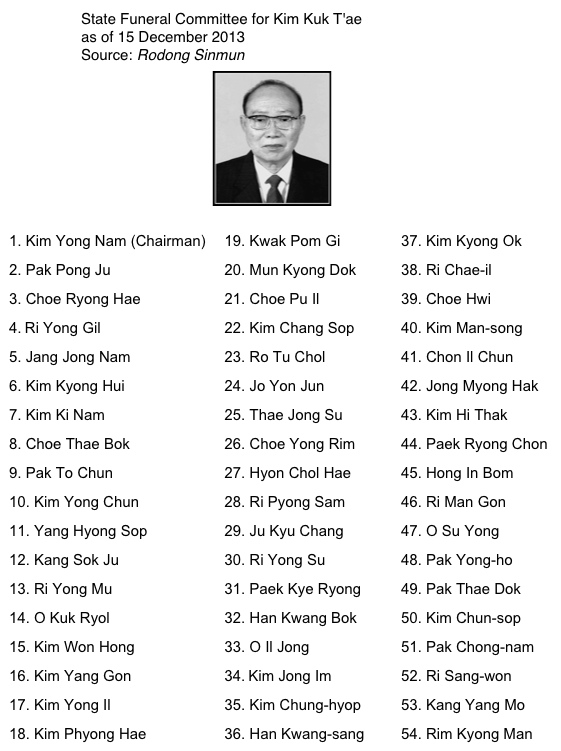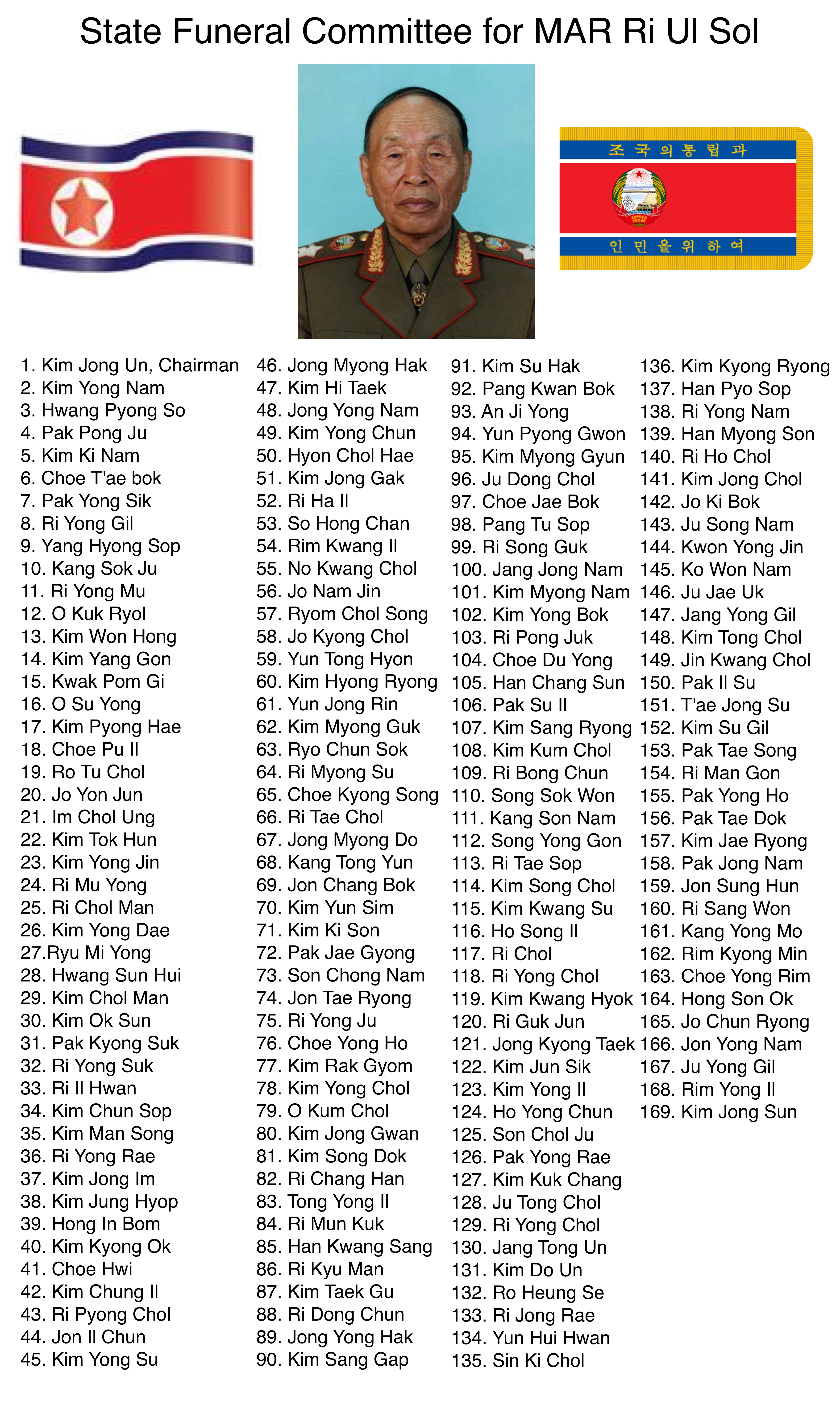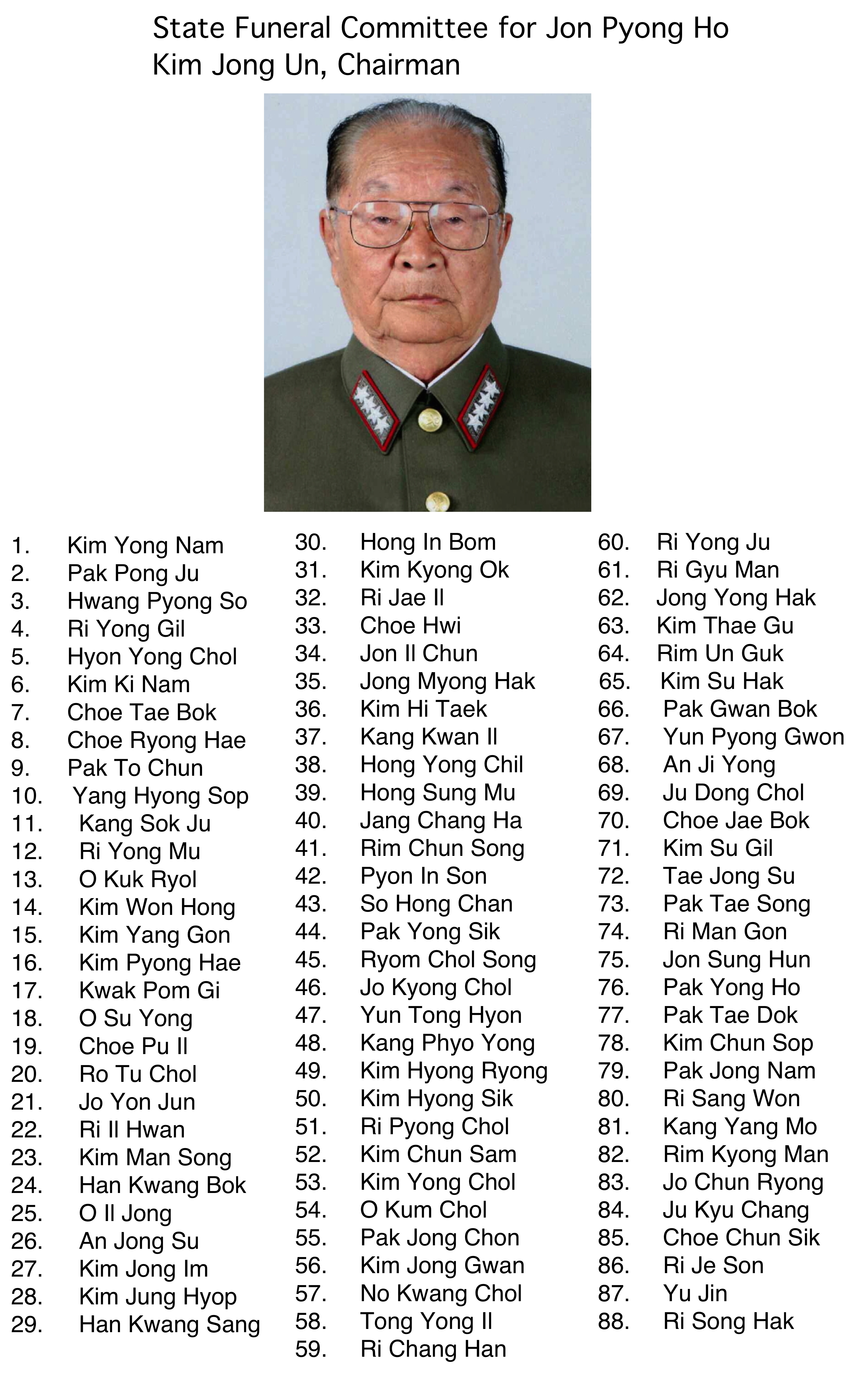Ri Ul Sol Funeral Committee: Who’s On, Who’s Not
Within hours of being disseminated by DPRK state media, the funeral committee of MAR Ri Ul Sol has attracted some attention for who is on it, and who is not. Because it assigns a number to individual cadres, the state (national) funeral committee list is one way for external observers to clue themselves into the formal hierarchy of the country’s political leadership. It is not unlike a platform or call out order, the sequence in which senior officials are named in state broadcasts about anniversary events and national meetings. These lists generally contain all of the same people–members of the party’s central leadership bodies, senior party department directors and deputy directors, members of the Korean People’s Army [KPA] high command and senior commanders, and senior government officials–and are often divided based on institutional affiliation (i.e. Political Bureau, CMC, Cabinet member) or formal position (party directors, deputy directors, corps command, etc.)
These lists–funeral, call-out or otherwise–should be read with caution. The DPRK does not hold full state funerals all too often (there have been five state funerals since 2010) so a funeral committee list is not a regular occurrence. The one consistency in these lists is that members of the Workers’ Party of Korea [WPK] Political Bureau (who hold concurrent senior party, army or state positions) always hold the first 20 slots (#1 through #20).

The national funeral committee “organized for the late comrade Kim Kuk-t’ae” on 15 December 2013 (Rodong Sinmun/NK Leadership Watch graphic).
After the Political Bureau members, a cursory review of the last three funeral lists from 2013 (Kim Kuk T’ae), 2014 (Jon Pyong Ho) and 2015 (Ri Ul Sol) finds that the funeral list is not a formal ranking of DPRK elites; funeral committees for party officials such as Kim Kuk T’ae and Jon Pyong Ho prioritized party cadres and civil-military rels officials (i.e. the names were higher up on the list) over uniformed officers of the KPA, while Ri Ul Sol’s funeral committee has numerous retired and elder KPA commanders, and MAR Ri’s peers and comrades of the 1st Revolutionary Generation are higher up on the list than current, politically active DPRK elites.
So, a number of officials with actual political (read: policymaking and personnel; direct access to the supreme leadership) power might find themselves at the bottom of a list, and senior cadres with grand job titles but little actual power, or retired cadres, are placed on the top of a list. For example, on the Ri Ul Sol Funeral Committee, current chairman of the Second Economic Committee [SEC] (Second Economy Commission) Jo Chun Ryong is ranked #165, while former SEC Chairman Kim Chol Man is ranked #29. Jo is the chief operating officer over the DPRK’s arms and logistics industries, as well as a member of the power National Defense Commission [NDC]. He manages thousands of supervisors, functionaries and workers and discharges myriad policymaking and administrative tasks on a given day. Kim Chol Man, on the other hand, is a member of the WPK Central Committee but has otherwise largely retired and is not active in the DPRK’s political culture.
With all of this in mind, the Ri Ul Sol State Funeral Committee list does offer some insights (takeaways, if you like) about the current DPRK political culture.
Choe Ryong Hae The $64,000 question for Pyongyang watchers is what has become of Choe Ryong Hae. With the initial DPRK state media reportage about Ri Ul Sol’s demise and its attendant funeral committee list, ROK experts immediately noticed that Choe, a member of the WPK Political Bureau Presidium (standing committee) and WPK Secretary, was not included on MAR Ri’s funeral committee. A senior cadre of Choe’s stature should technically be in the top ten officials of a national funeral committee. Choe, after all, was #3 on Kim Kuk Tae’s funeral committee in December 2013 and #8 on Jon Pyong Ho’s funeral committee in July 2014.
Choe’s status has been previously been questionable. In February 2014 numerous sources claimed that Choe was under investigation by the Military Security Command when he was serving as Director of the KPA General Political Department [GPD]. According to these accounts, Choe’s office was raided and he was placed under house arrest. Choe later resurfaced, accompanying Kim Jong Un on a field inspection of an air force unit, however in April 2014 he was removed from the National Defense Commission and dismissed as GPD Director.
Due to his status as a Pyongyang princeling (he is the son of Choe Hyon, a 1st generation revolutionary and former defense minister) and hss close ties to the Kim Family (particularly Jong Un’s aunt Kim Kyong Hui), Choe’s landing was soft and he became a WPK Secretary. Choe has traveled to the ROK, Russia and China as Kim Jong Un’s personal emissary, and he helped orchestrate a visit by senior Chinese leadership to the party’s 70th anniversary celebrations held last month. And yet, Choe Ryong Hae may be like other senior DPRK elites who’ve enjoyed a career comeback only to be marginalized, or worse (the most famous example here would be the late Jang Song Taek).
Choe may yet turn up. If he does we are likely to see him lining up with other senior officials at Ri Ul Sol’s funeral. If he does not then it will corroborate the chatter we heard back in February 2014 that his status was questionable. But the question will then be why Choe Ryong Hae has been sidelined. When Choe was under investigation by the Military Security Command, it was alleged that he had been on the wrong side of a business dispute among other core elites. Choe is also to reputed to have a colorful private life and has previously been implicated in incidents of financial malfeasance. But Choe may also face dismissal because of something linked to his external activities. Did the senior Chinese delegation arrive in Pyongyang in October with a briefcase less full of consideration and policies than Choe said it would? Did Choe have a Cool Hand Luke and miscommunicate a strategic policy position (an FDI or delaying a space launch longer than Pyongyang intended)?
O Il Jong While Choe’s exclusion from the funeral committee list was rather glaring, a more subtle exclusion was that of the incumbent director of the WPK Military Affairs Department. Having bona fide military credentials along with a long career in the military and security services, the decedent Ri Ul Sol occupied prime real estate at the intersection of civil-military relations in the DPRK’s political culture. The Military Affairs Department as an institution is the epitome of the North’s civil-military relations, formally tasked by the Party Central Military Commission to formulate and communicate military policies to the KPA. However, O Il Jong its last known director appears to have been left off the funeral committee.
Like Choe Ryong Hae, O Il Jong is also a princeling related to O Jin U and other members of the O Family. If Choe and O are still active and have retained their positions, then perhaps they were left off the funeral committee for personal reasons. While the 1st Revolutionary Generation is now commonly associated with their pledges of “single-hearted unity” familial and personal cleavages historically existed among the old partisan fighters (ask the Kapsan Faction who were purged in the 1960s). So. Choe Ryong Hae and O Il Jong may well have been deliberately excluded because Ri Ul Sol had a personal problem with their fathers or with their families. It should be added here that Ri Ul Sol was always an outlier among the 1st generation and had to be persuaded by Kim Jong Il to come out in support of Jong Un’s hereditary succession.
Kim Kyong Ok Kim was Jong Un’s key political enforcer as a senior deputy director of the WPK Organization Guidance Department [OGD]. He has not been seen in DPRK state media in months and there were rumors that he had been executed during a purge of central party officials that occurred during fall 2014. There have also been rumors that Kim is in poor health. Kim Kyong Ok has most likely been removed from the Central Military Commission (a regular fixture at its meetings, he has failed to appear at any of the expanded sessions held in 2015), but he is listed #40 on Ri Ul Sol’s funeral committee, in the same slots as other OGD deputy directors.
Ri Jae Il Ri is responsible for the daily management and administration of DPRK state media and is one of the DPRK’s key image makers. He has accompanied Kim Jong Un to a number of on-site visits and inspections through October and was observed attending the parade in Pyongyang in October. He was listed #32 on Jon Pyong Ho’s funeral committee and #38 on Kim Kuk Tae’s funeral committee, however he is not listed on Ri Ul Sol’s funeral committee. Ri is in his 80s and he may be in poor health, however at least a dozen other elderly and infirm DPRK elites populate MAR Ri’s funeral committee so Ri Jae Il may have fallen out of favor or effectively retired.
Rumored Purged Officials Ri Ul Sol’s funeral committee includes the names of several former or current members the KPA high command and senior party cadres previously rumored to have been incarcerated or executed. Former Minister of People’s Security, Gen. Ri Myong Su, is listed #64. Gen. Ri was a protege of the late VMar Jang Song U, eldest brother of Jang Song Taek. General Ri had close ties and reported to Jang Song Taek during his time at MPS and was replaced in 2013. Following Jang’s execution, there were rumors that Gen. Ri had been incarcerated or executed.
Similarly former KPA Navy Commander Adm. Jong Myong Do is listed #67. Adm Jong disappeared from public view and unceremoniously replaced at exactly the same time as the public dismissal of former Chief of the KPA General Staff VMar Ri Yong Ho in summer 2012. Also former Director of the KPA General Logistical Department and former Vice Minister of the People’s Armed Forces Col. Gen. Jon Chang Bok is listed #69. Like Jong Myong Do, Col. Gen. Jon was disappeared and has resurfaced.
Of these Lazarus-like listings, the most notable is Han Kwang Sang. Han is listed #85, but during May 2015 was rumored to have been executed (along, more notoriously, with former defense minister Gen. Hyon Yong Chol). Han Kwang Sang’s career skyrocketed during the transitional period from 2009 to 2013 in which he successively served as deputy director and director of the WPK Finance and Accounting Department. He made numerous appearances with both Kim Jong Il and Kim Jong Un. Han’s last observed appearance in public was in March 2015 and two month thereafter he was rumored to have been executed. Given recent ROK reporting about a slew of DPRK migrants from the foreign currency earning apparatus defecting to ROK, there was a fairly reasonable (and circumstantial) argument that Han was held responsible and executed. Despite his appearance on the funeral committee, Han has migrated to another position, most likely in the NDC apparatus. Instead of being listed with other WPK department directors his name appears with 2nd tier members of the KPA high command and NDC section chiefs.
Old Soldiers Ri Ul Sol’s funeral committee is, natch, populated with his old colleagues and friends. What is surprising is the number of former members of the KPA high command that are still alive and in good standing with the regime. Their appearance dispels rumors that they were purged or fell out of favor, but were allowed to retire. Some of these officials appeared at events marking the anniversary of the Fatherland Liberation War during July 2013 but their presence was not reported in DPRK state media. Among the old soldiers listed on MAR Ri’s funeral committee are: former NDC Vice Chairman and Minister of the People’s Armed Forces VMar Kim Yong Chun (#49) former 1st Vice Minister of the People’s Armed Forces VMar Hyon Chol Hae (#50); former WPK Military Affairs Department Director and CMC Member VMar Ri Ha Il (#52); former Director of the KPA General Staff Operations Bureau and KJI close aide Gen. Kim Myong Guk; former KPA Navy Commander Kim Yun Sim (#70); former General Political Department deputy director Gen. Kim Ki Son (#71); and former General Political Department deputy and Vice Minister of the People’s Armed Forces, Gen. Pak Jae Gyong (#72). In an interesting arrangement the old soldiers are listed in alternating patterns with current members of the KPA high command.
Kim Family At the bottom of the list, among several 2nd tier KPA commanders, at #141 is the name Kim Jong Chol, which may be a rare public mention of Kim Jong Un’s elder brother. Not listed, interestingly, is Ko Su Il who is Jong Un’s and Jong Chol’s maternal uncle and whose political power was rumored to be growing during the last two years.

